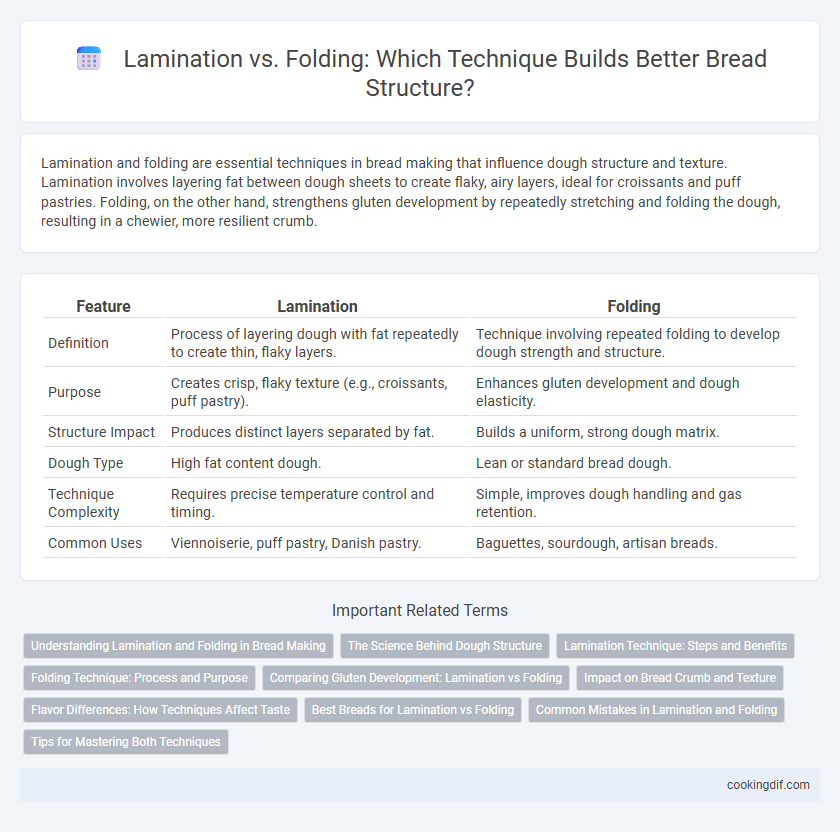Lamination and folding are essential techniques in bread making that influence dough structure and texture. Lamination involves layering fat between dough sheets to create flaky, airy layers, ideal for croissants and puff pastries. Folding, on the other hand, strengthens gluten development by repeatedly stretching and folding the dough, resulting in a chewier, more resilient crumb.
Table of Comparison
| Feature | Lamination | Folding |
|---|---|---|
| Definition | Process of layering dough with fat repeatedly to create thin, flaky layers. | Technique involving repeated folding to develop dough strength and structure. |
| Purpose | Creates crisp, flaky texture (e.g., croissants, puff pastry). | Enhances gluten development and dough elasticity. |
| Structure Impact | Produces distinct layers separated by fat. | Builds a uniform, strong dough matrix. |
| Dough Type | High fat content dough. | Lean or standard bread dough. |
| Technique Complexity | Requires precise temperature control and timing. | Simple, improves dough handling and gas retention. |
| Common Uses | Viennoiserie, puff pastry, Danish pastry. | Baguettes, sourdough, artisan breads. |
Understanding Lamination and Folding in Bread Making
Lamination in bread making involves incorporating layers of fat between dough, creating a flaky, tender crumb characteristic of croissants and Danish pastries. Folding, a technique of repeatedly stretching and folding the dough, strengthens gluten development, resulting in an even crumb and improved dough elasticity. Understanding these methods allows bakers to manipulate texture and structure, optimizing the bread's rise and mouthfeel.
The Science Behind Dough Structure
Lamination in bread involves layering dough with fat to create distinct, flaky layers by inhibiting gluten network formation, which leads to a tender, airy crumb. Folding, in contrast, enhances gluten development by realigning and strengthening the protein strands, resulting in a chewier and more elastic texture. Understanding the science behind these techniques allows bakers to manipulate dough structure for specific bread characteristics such as flakiness in croissants or chewiness in sourdough.
Lamination Technique: Steps and Benefits
Lamination in bread making involves layering dough with fat through repeated rolling to create a flaky, airy structure essential for pastries like croissants. This technique enhances gluten development and traps steam during baking, resulting in distinct layers and a tender crumb. Benefits include improved texture, extended shelf life, and a richer mouthfeel compared to traditional folding methods.
Folding Technique: Process and Purpose
The folding technique in bread making involves repeatedly folding the dough during fermentation to develop gluten structure and improve gas retention. This process enhances dough strength and elasticity, resulting in a more open crumb and better rise. Unlike lamination, folding emphasizes gluten development through gentle stretching rather than layering fat between dough sheets.
Comparing Gluten Development: Lamination vs Folding
Lamination and folding both enhance gluten development but through different mechanisms affecting bread structure. Lamination involves rolling and folding dough with fat layers, creating thin gluten strands and a flaky texture ideal for croissants or puff pastries. Folding, often used in sourdough or artisan breads, strengthens gluten networks by gently aligning proteins, resulting in a chewier crumb and superior gas retention.
Impact on Bread Crumb and Texture
Lamination creates distinct, thin layers of dough and fat that result in a flaky, airy crumb with a tender, crisp texture, ideal for croissants and puff pastries. Folding, by contrast, involves repetitive folding of dough to develop gluten strength, producing a denser crumb with a chewier texture typical of rustic or artisan breads. The choice between lamination and folding significantly affects the bread's crumb openness, chewiness, and overall mouthfeel.
Flavor Differences: How Techniques Affect Taste
Lamination creates distinct, flaky layers by incorporating butter evenly throughout the dough, resulting in a delicate texture and rich, buttery flavor that enhances the bread's sweetness. Folding develops gluten strength by gently layering dough without added fat, producing a chewier crumb and a more robust, yeasty taste with subtle caramel notes. These structural techniques significantly impact flavor profiles, with lamination emphasizing buttery richness and folding highlighting the bread's natural fermentation character.
Best Breads for Lamination vs Folding
Lamination creates layered, flaky textures ideal for croissants, puff pastries, and Danish breads, using extensive rolling and folding of butter within dough. Folding methods, which involve simpler folding techniques without continuous butter layers, produce strong gluten structures suitable for baguettes, ciabatta, and sourdough breads. Choosing lamination enhances tenderness and crispness, while folding prioritizes airy crumb and crust development in artisan breads.
Common Mistakes in Lamination and Folding
Common mistakes in lamination include overworking the dough, which leads to tough layers instead of light, flaky ones, and improper chilling that causes butter leakage. In folding, uneven dough thickness and inconsistent turns result in irregular crumb structure and reduced rise. Both lamination and folding require precise temperature control and technique to maintain distinct, airy layers essential for artisan bread quality.
Tips for Mastering Both Techniques
Mastering lamination and folding techniques enhances dough strength and crumb structure in bread baking. Use lamination to evenly distribute butter for flaky layers, applying consistent pressure and temperature control to prevent butter leakage. For folding, perform multiple turns with precise timing to develop gluten layers, ensuring dough relaxation between folds to maintain elasticity and prevent tearing.
Lamination vs Folding for structure Infographic

 cookingdif.com
cookingdif.com